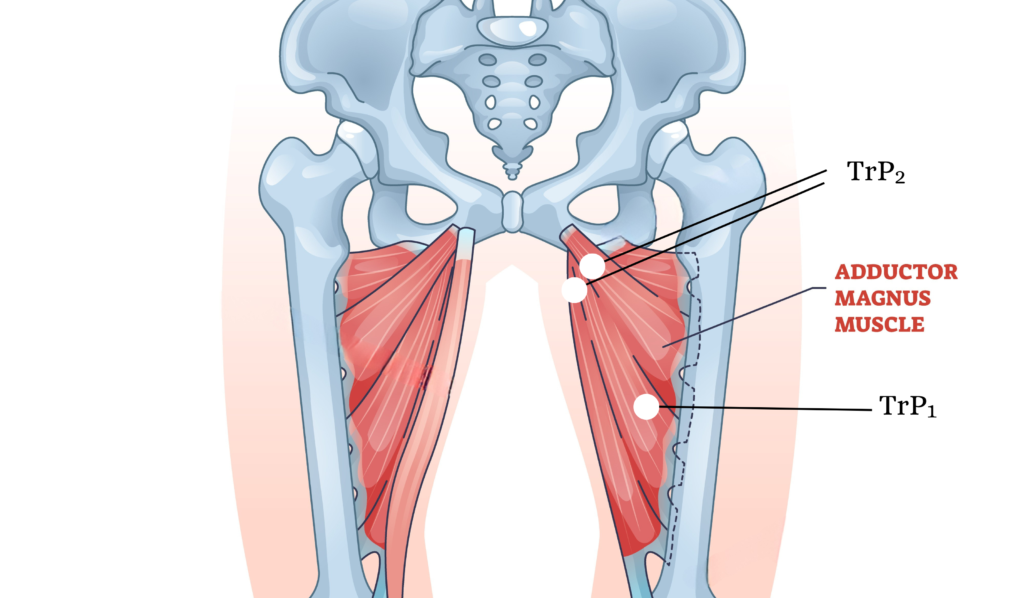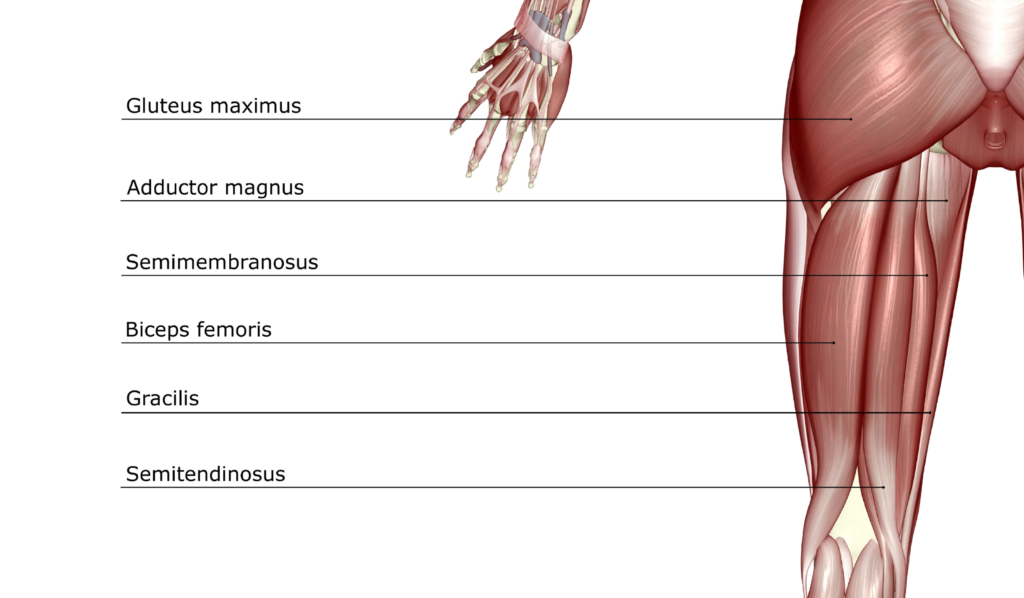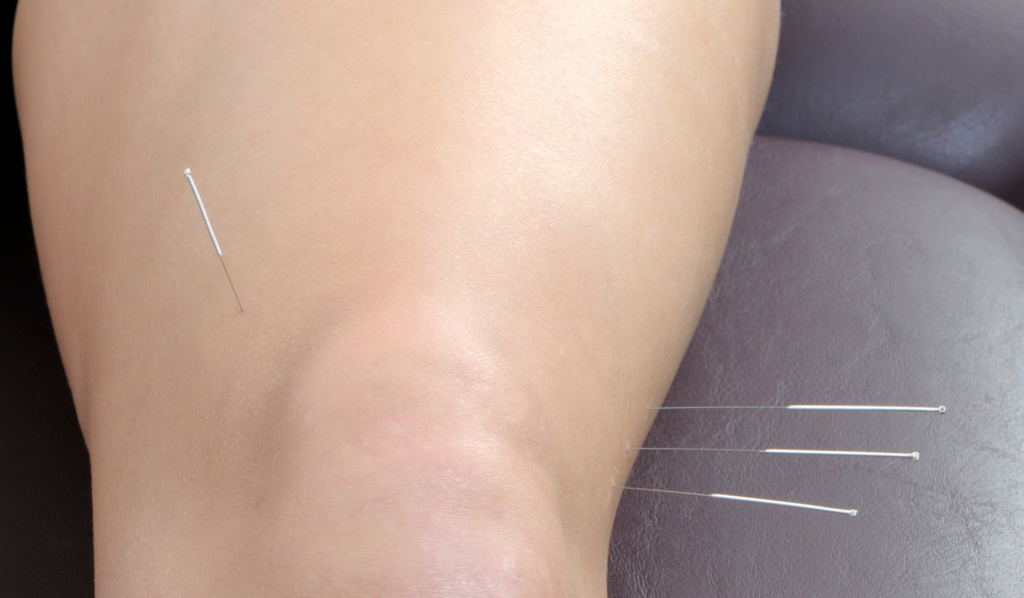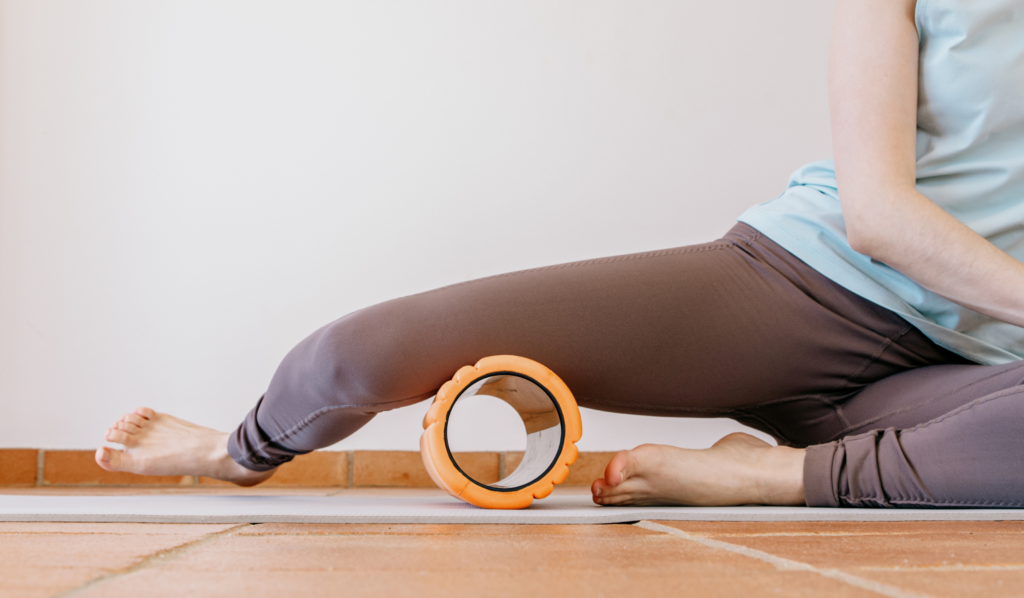Acupuncture for Adductor Magnus Pain
Pain in the adductor magnus can make even simple movements uncomfortable, whether it’s a dull ache or a sharp restriction that limits mobility. Walking, exercising, or even sitting for long periods can become a challenge, leading to frustration and discomfort that lingers without relief. Over time, tightness in this deep inner thigh muscle can affect overall movement and make daily activities feel more difficult than they should.
Acupuncture provides a natural and effective way to release tension, improve circulation, and reduce inflammation. By targeting the root cause of discomfort, it helps restore mobility and support the body’s healing process. Whether the pain is recent or something that has persisted, acupuncture offers a gentle yet powerful solution for lasting relief.
Acupuncture for Adductor Magnus Pain
Pain in the adductor magnus can make even simple movements uncomfortable, whether it’s a dull ache or a sharp restriction that limits mobility. Walking, exercising, or even sitting for long periods can become a challenge, leading to frustration and discomfort that lingers without relief. Over time, tightness in this deep inner thigh muscle can affect overall movement and make daily activities feel more difficult than they should.
Acupuncture provides a natural and effective way to release tension, improve circulation, and reduce inflammation. By targeting the root cause of discomfort, it helps restore mobility and support the body’s healing process. Whether the pain is recent or something that has persisted, acupuncture offers a gentle yet powerful solution for lasting relief.
Key Takeaways
-
Acupuncture relieves adductor magnus pain by releasing deep muscle tension, reducing inflammation, and restoring mobility without drugs or surgery.
-
Trigger points in the adductor magnus often refer pain to the groin, thigh, or knee and can be effectively treated through targeted acupuncture.
-
Pain in the adductor magnus muscle can be caused by overuse, poor posture, or muscle imbalances, especially in active individuals or those who sit for long periods.
-
Treating adductor magnus dysfunction with acupuncture supports healing by improving circulation and balancing hip-related muscle groups.
-
Accurate identification of adductor magnus trigger points is essential to avoid misdiagnosis and ensure long-term relief through proper therapeutic care.
Understanding the Adductor Magnus Muscle
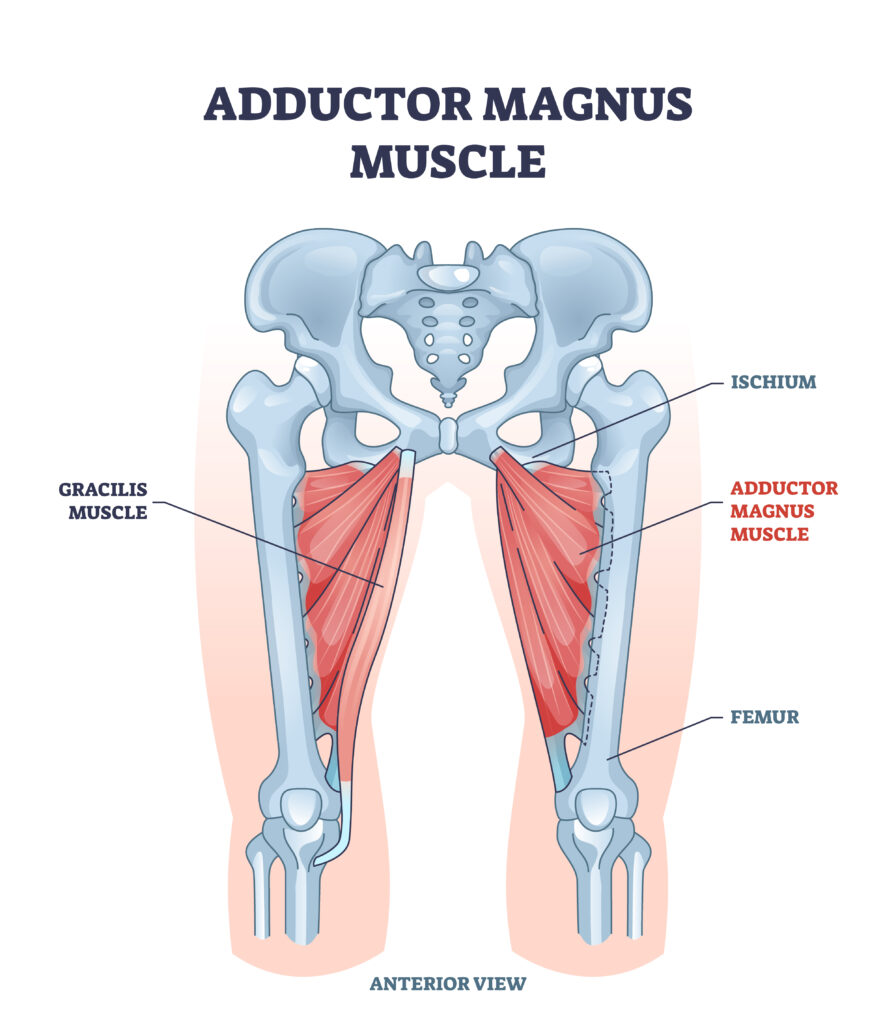
Adductor magnus muscle with ischium and femur skeleton outline diagram. Labeled educational gracilis muscular system from anterior view vector illustration. Human body hips and legs inner structure.
About the Muscle
The adductor magnus is a powerful muscle in the inner thigh that plays a key role in hip movement and lower-body stability. As one of the primary adductors, it helps draw the leg toward the midline while also assisting in hip extension and stabilization. This muscle is engaged in nearly every walking, running, or lateral movement, making it essential for balance, posture, and overall mobility.
Because of its deep location and wide attachment points, the adductor magnus often becomes tight or overworked, particularly in athletes, active individuals, and those with muscle imbalances or prolonged sedentary habits. Discomfort in this area can lead to restricted movement, strain, and even referred pain in the groin, knee, or lower back.
Origin and Insertion of Adductor Magnus
The adductor magnus originates from two points:
- The pubis and ischium, which are part of the pelvic bones.
- The femur, where it inserts along a large portion of the inner thigh.
Its broad attachment makes it a versatile muscle that not only adducts the leg but also extends and stabilizes the hip joint. However, because of its size, function, and constant engagement in movement, it is prone to overuse, tightness, and the development of trigger points.
Adductor Magnus Actions
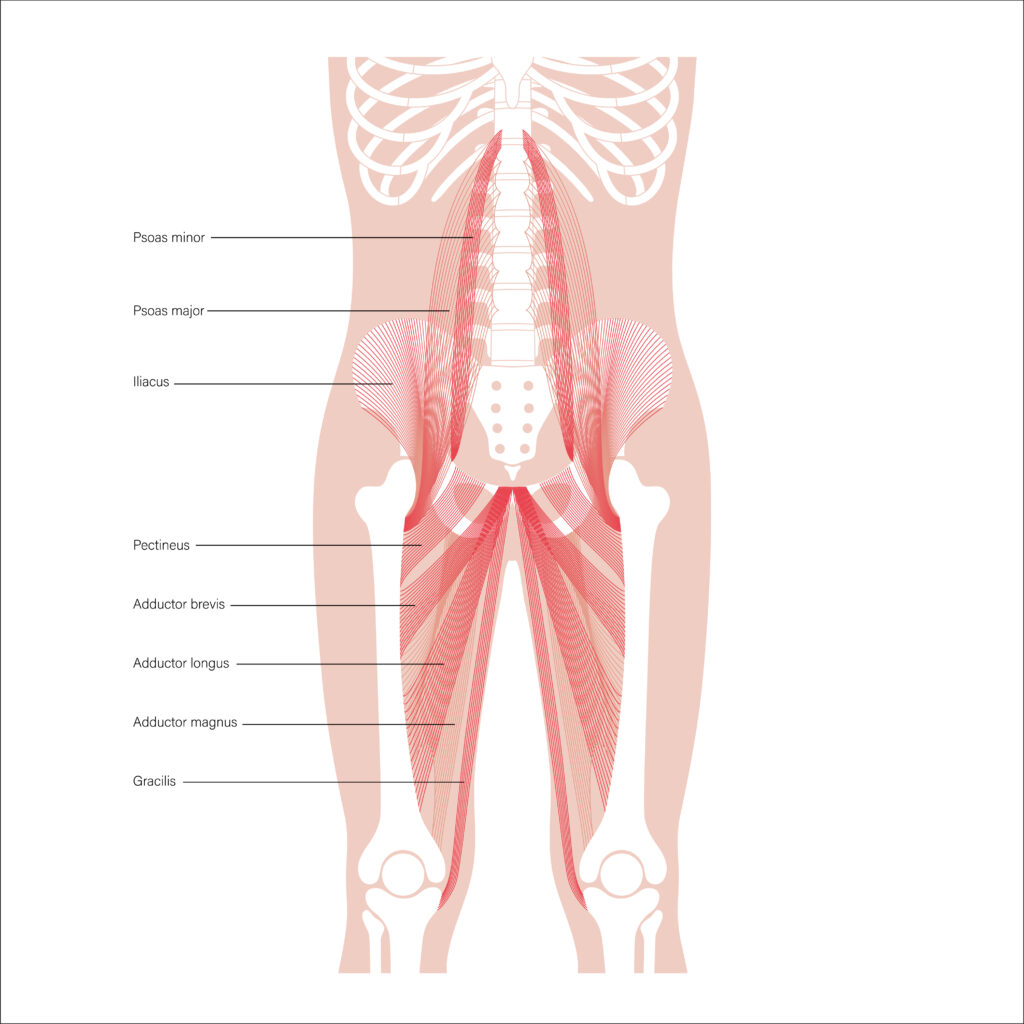
Psoas muscle and adductor magnus. Structure of muscular system and human skeleton. Man body anatomical poster with bones of pelvis, legs, spine and ribs. Medical flat vector illustration. X ray image.
The adductor magnus has a dual role as both an adductor and an extensor of the hip. It works with synergistic muscles such as:
- Gracilis
- Pectineus
- Adductor longus
These muscles coordinate to bring the leg toward the body’s midline. At the same time, the adductor magnus opposes the gluteus medius, which controls hip abduction and lateral stabilization. This balance between adduction and abduction is important for maintaining a strong, well-aligned posture and preventing compensatory movement patterns that can lead to pain and dysfunction.
Because of its role in both dynamic movement and postural support, the adductor magnus is vulnerable to muscle imbalances, strain, and tightness, particularly in individuals who engage in repetitive lower-body movements or have restricted hip mobility. Addressing muscle tension and trigger points in this area is key to maintaining optimal movement and preventing chronic discomfort.
Recognizing Pain and Dysfunction
Pain in the adductor magnus often presents as a deep, aching discomfort in the inner thigh, which may feel tight, stiff, or tender to the touch. This discomfort typically worsens with activities that engage the inner thigh muscles. In some cases, individuals may experience a pulling sensation or sharp pain when stretching or contracting the muscle.
Other signs that may indicate adductor magnus dysfunction include:
- Difficulty bringing the legs together due to weakness or tightness
- Pain that extends to the groin or knee, often mistaken for a different injury
- Discomfort when sitting for long periods, particularly if the muscle is tight
- A feeling of instability in the hip or thigh, especially during movement
If left untreated, pain in this area can lead to compensatory movement patterns, placing strain on surrounding muscles such as the hamstrings, quadriceps, and hip flexors, further contributing to dysfunction.
Signs and Symptoms of Adductor Magnus Trigger Points
Trigger points in the adductor magnus can cause localized pain as well as referred pain in the groin, knee, or even lower back. These hypersensitive spots develop when the muscle fibers become tight and contracted, restricting blood flow and preventing proper relaxation.
Common symptoms associated with adductor magnus trigger points include:
- Deep, persistent pain in the inner thigh that may feel sore or bruised
- Pain that intensifies when pressing on specific spots in the muscle
- A burning or aching sensation that extends down the leg
- Reduced range of motion in the hip and thigh, making movements like lunging or stretching uncomfortable
Since trigger points can mimic other conditions, such as groin strains or nerve compression, it is important to accurately identify their location and impact before seeking treatment.
Adductor Magnus Trigger Points
Trigger points in the adductor magnus commonly form in response to:
- Muscle overuse from running, cycling, or weightlifting
- Weakness or imbalance in surrounding hip muscles
- Poor posture or prolonged sitting leading to chronic tension
- Sudden injuries or improper warm-ups before activity
Unlike generalized muscle tightness, trigger points create specific areas of tenderness that, when pressed, can radiate pain into the surrounding region. They often develop near the muscle’s origin at the pelvis or along its insertion points on the femur.
Where Are Adductor Magnus Trigger Points?
These trigger points are typically located along the inner thigh, closer to the pelvis or mid-thigh region. They can sometimes extend down toward the knee, creating discomfort that is mistaken for knee-related issues.
Two primary trigger points tend to develop in the adductor magnus:
Trigger Point #1 (TrP#1): Located in the midportion of the muscle, this is the most common area for trigger points to form.
Trigger Point #2 (TrP#2): Positioned higher up near the pubic bone, this trigger point may involve one or two spots within the same region.
Identifying trigger points early and addressing them through targeted treatments like acupuncture, stretching, and manual therapy can prevent the pain from becoming chronic or leading to compensatory movement patterns.
Adductor Magnus Trigger Point Referral Pattern
Referred pain from adductor magnus trigger points does not always remain localized to the inner thigh. Instead, it can:
- TrP#1 Referral Pattern: Pain radiates into the groin below the inguinal ligament and downward along the anteromedial aspect of the thigh, almost reaching the knee. This type of groin pain often feels deep, making it difficult for patients to pinpoint the exact location.
- TrP#2 Referral Pattern: Causes internal pelvic pain, which may affect the pubic bone, bladder, rectum, vagina, or penis. Some describe this pain as a sharp, shooting sensation—like an “exploding firecracker” inside the pelvis.
Because of these overlapping pain patterns, misdiagnosis is common, and many individuals mistakenly treat the symptoms rather than addressing the root cause.
Associated Trigger Points
Tightness in the adductor magnus often leads to dysfunction in other muscles that support the hip and thigh. The most commonly affected muscles include:
- Hamstrings, particularly the medial hamstring group, which assists in hip extension
- Quadriceps, especially the vastus medialis, due to its connection near the knee
- Hip flexors, including the iliopsoas, which compensate when the adductors become restricted
Treating adductor magnus pain in isolation may not always provide complete relief. A comprehensive approach that targets multiple trigger points and muscle imbalances is often necessary for long-term recovery.
Differential Diagnosis
Since adductor magnus pain can overlap with other conditions, it is important to differentiate between muscle-related dysfunction and other possible causes of pain, such as:
- Groin strains or sports hernias, which involve ligament or tendon damage
- Hip joint impingement, which may cause stiffness and clicking sensations
- Nerve entrapment syndromes, such as obturator nerve irritation, which can create radiating pain in the thigh
- Referred pain from lower back issues, including sciatica or sacroiliac joint dysfunction
Synergists and Antagonists
The adductor magnus does not function in isolation. It works in coordination with synergistic and antagonistic muscles to maintain hip stability and smooth movement.
Synergistic muscles (assist in adduction and extension):
- Adductor longus and brevis
- Gracilis
- Pectineus
- Hamstrings (especially the semimembranosus and semitendinosus)
Antagonistic muscles (control opposing movements):
- Gluteus medius and minimus, responsible for hip abduction
- Tensor fasciae latae (TFL), involved in lateral stabilization of the hip
When the adductor magnus becomes tight or dysfunctional, these synergistic and antagonistic muscles may have to compensate, leading to further muscle imbalances and secondary pain patterns. Treating both the adductor magnus and its supporting muscle groups is key to achieving full recovery and preventing reinjury.
Causes and Contributing Factors
Pain in the adductor magnus can develop from a variety of factors, often linked to muscle overuse, poor movement mechanics, or lack of flexibility. Some of the most common causes include:
- Overuse injuries – Activities such as running, cycling, or weightlifting can place repetitive stress on the adductor magnus, leading to strain, tightness, and the formation of trigger points.
- Prolonged sitting or inactivity – Sitting for extended periods can cause the adductors to become shortened and tight, contributing to discomfort and restricted movement.
- Sudden movements or trauma – Quick lateral shifts, abrupt stops, or unexpected falls can strain the adductor magnus, leading to muscle tears or irritation.
- Weak or imbalanced hip muscles – When hip abductors (such as the gluteus medius) are weak, the adductor magnus may become overworked, leading to compensation patterns and pain.
- Poor posture or biomechanics – Incorrect gait mechanics, improper squat form, or uneven weight distribution can place excessive strain on the inner thigh, increasing the risk of muscle dysfunction.
Treatment and Corrective Actions
Acupuncture for Adductor Magnus Pain
Acupuncture is a highly effective therapy for treating adductor magnus pain by targeting muscle tension, trigger points, and inflammation. This treatment works by:
- Stimulating trigger points to release tight muscle fibers and reduce spasms.
- Improving blood circulation, which promotes healing and reduces stiffness.
- Reducing inflammation and nerve sensitivity, leading to pain relief.
- Restoring the natural function of the adductor magnus, allowing for proper movement and muscle coordination.
Acupuncture is particularly beneficial for individuals who experience chronic muscle tightness, recurring strains, or postural imbalances, as it helps reset the neuromuscular system and relieve tension without invasive procedures.
How Acupuncture Works
Acupuncture works by stimulating specific points in the body to encourage natural healing, reduce pain, and restore muscle function. In the case of adductor magnus pain, fine needles are inserted into trigger points and meridian pathways to help release muscle tension, improve circulation, and reduce inflammation.
The process involves:
- Releasing endorphins, the body’s natural painkillers, to relieve discomfort.
- Stimulating blood flow to the affected area, promoting oxygen and nutrient delivery for faster healing.
- Reducing muscle spasms and stiffness, allowing for greater mobility and range of motion.
- Regulating the nervous system, which helps deactivate pain signals and restore balance.
Acupuncture can be combined with other treatments, such as manual therapy, exercise, and postural correction, to ensure lasting relief from adductor magnus dysfunction.
Benefits of Acupuncture for Adductor Magnus Pain
Acupuncture offers multiple benefits for individuals experiencing adductor magnus pain. Unlike medications or invasive procedures, acupuncture works naturally with the body to provide relief while also addressing the root cause of pain.
Key Benefits:
- Non-invasive and drug-free – A natural alternative to pain medications and anti-inflammatory drugs.
- Targets the source of pain – Instead of masking symptoms, acupuncture helps resolve muscle dysfunction and imbalances.
- Reduces chronic tension – Helps deactivate trigger points and prevent recurring tightness.
- Promotes faster recovery – Improves blood circulation to accelerate healing in the muscle.
- Supports overall muscle health – Encourages proper movement patterns, reducing the risk of compensatory pain in other areas.
Other Related Conditions
Acupuncture is not only beneficial for adductor magnus pain but also for other conditions that affect the hip, thigh, and surrounding muscles. Because of its ability to release tension, reduce inflammation, and improve neuromuscular function, acupuncture can be effective for:
- Piriformis Syndrome – A condition where the piriformis muscle compresses the sciatic nerve, leading to radiating pain in the hip, buttock, and leg. Acupuncture can help relieve nerve irritation and reduce muscle tightness.
- Gluteus Minimus Trigger Points – Tight knots in the gluteus minimus muscle can refer pain to the hip and lateral thigh, mimicking sciatica. Acupuncture helps release these trigger points and improve muscle function.
- Tensor Fasciae Latae (TFL) Pain – The TFL muscle, which helps stabilize the hip, can become tight and overactive, contributing to hip and thigh discomfort. Acupuncture can restore balance and improve mobility.
By addressing multiple sources of pain in the hip and thigh region, acupuncture offers a comprehensive solution for individuals struggling with chronic tension and movement restrictions.
Treatment for Adductor Magnus Pain
While acupuncture is a key treatment option, a comprehensive approach that includes manual therapy and movement-based rehabilitation can further accelerate recovery.
- Trigger point acupuncture – Specifically targets painful knots in the muscle to release tension.
- Dry needling – A deeper form of acupuncture that penetrates trigger points to relieve chronic tightness.
- Myofascial release and manual therapy – Helps break down muscle adhesions and improve flexibility.
- Stretching and strengthening exercises – Prevents recurrent pain by improving muscle balance and joint stability.
- Heat therapy – Increases blood flow to the muscle, reducing stiffness and promoting relaxation.
Corrective Actions
Preventing recurring pain and dysfunction requires proactive muscle care and movement optimization. Incorporating these corrective actions into daily routines can help maintain muscle health and flexibility:
- Regular stretching and mobility work – Improves range of motion and prevents tightness from returning.
- Strengthening hip abductors and stabilizing muscles – Balances muscle engagement, preventing overuse of the adductor magnus.
- Maintaining proper posture and ergonomics – Ensures even weight distribution and optimal movement patterns.
- Gradual reintroduction of activity – Allows the muscle to adapt to increasing loads without reinjury.
Potential Risks and Considerations of Acupuncture for Adductor Magnus Pain
Acupuncture is widely regarded as a safe and effective treatment for muscle pain when performed by a trained practitioner. However, as with any therapeutic intervention, there are potential risks and considerations to be aware of:
Possible Risks of Acupuncture
- Minor Bruising or Soreness: Some individuals may experience mild bruising or soreness at the insertion sites, especially if trigger points are deeply activated.
- Temporary Fatigue or Dizziness: A small percentage of patients report feeling lightheaded or fatigued after a session, which usually resolves within a few hours.
- Infection Risk: While rare, there is a small risk of infection if sterile, single-use needles are not properly used. This is why seeking treatment from a licensed and experienced acupuncturist is crucial.
- Increased Sensitivity: Some patients may experience temporary heightened sensitivity or muscle twitching, particularly if dry needling techniques are used.
- Pre-existing Medical Conditions: Individuals with bleeding disorders, low blood pressure, or those on blood-thinning medication should consult their healthcare provider before undergoing acupuncture.
How to Minimize Risks
- Always choose a licensed and reputable acupuncturist.
- Communicate any pre-existing health conditions before treatment.
- Stay hydrated and eat a light meal before your session to reduce dizziness.
- Follow your acupuncturist’s aftercare recommendations to enhance recovery and prevent discomfort.
While acupuncture for adductor magnus pain is a safe and effective option for many, being aware of potential risks ensures a positive and informed treatment experience.
Supporting Adductor Magnus Health with Acupuncture
The adductor magnus is essential for lower-body movement, and dysfunction in this muscle can cause discomfort and restricted mobility. At ACA Acupuncture and Wellness, our practitioners use acupuncture to target pain at its source, promoting recovery and muscle balance. Whether you’re managing chronic tightness or recovering from strain, acupuncture combined with corrective exercises can support long-term relief and improved movement. By enhancing circulation and reducing muscular tension, acupuncture helps restore flexibility and strength. Our personalized treatment plans ensure that each session is tailored to your specific needs, providing a comprehensive approach to healing.
Sources:
Park, H. S., Jeong, H. I., Sung, S.-H., & Kim, K. H. (2023). Acupuncture treatment for hip pain: A systematic review and meta-analysis. Journal of Integrative Medicine, 21(4), 345–360.
Jeno, S. H., Launico, M. V., & Schindler, G. S. (2023). Anatomy, bony pelvis and lower limb: Thigh adductor magnus muscle. StatPearls. StatPearls Publishing.
Frequently Asked Questions
How long does it take for acupuncture to relieve Adductor Magnus pain?
Relief can vary, but many experience improvements within a few sessions. Chronic conditions may require multiple treatments over several weeks. The severity of the pain, underlying muscle imbalances, and individual response to acupuncture all play a role in how quickly results are felt. A personalized treatment plan that includes acupuncture, stretching, and strengthening exercises can help speed up recovery and prevent recurrence.
Can acupuncture completely eliminate trigger points in the Adductor Magnus?
Yes, consistent acupuncture sessions can effectively deactivate trigger points and prevent recurrence when combined with corrective exercises. Acupuncture helps release muscle knots by improving blood flow and reducing nerve sensitivity, allowing the muscle fibers to relax. However, maintaining results often requires lifestyle adjustments, such as proper posture, mobility work, and avoiding repetitive strain on the muscle.
Can Acupuncture help with groin pain related to the Adductor Magnus?
Yes, acupuncture can be an effective treatment for groin pain caused by adductor magnus dysfunction, trigger points, or muscle strain. Since the adductor magnus attaches near the groin, tightness or injury in this muscle can lead to radiating discomfort in the inner thigh and pelvic area. Acupuncture helps by reducing muscle tension, increasing circulation, and relieving nerve sensitivity in the affected area.
When should I seek professional help for persistent muscle pain?
If pain persists despite self-care, stretching, and strengthening, or worsens over time, consulting a licensed acupuncturist or physical therapist is recommended. Ignoring chronic pain can lead to compensatory movement patterns, which may cause discomfort in surrounding areas like the lower back, hips, or knees. Early intervention can prevent long-term dysfunction and help restore full mobility before the pain becomes a bigger issue.
Can acupuncture help prevent future Adductor Magnus pain?
Yes, regular acupuncture treatments can help maintain muscle balance, improve circulation, and prevent excessive tightness in the adductor magnus. When combined with corrective exercises, posture adjustments, and mobility training, acupuncture can reduce the risk of trigger point formation and chronic muscle tension. Addressing underlying movement patterns and strengthening supporting muscles like the glutes and hip stabilizers also plays a key role in preventing future discomfort.
Are there any side effects of acupuncture for Adductor Magnus pain?
Acupuncture is generally safe, but some individuals may experience mild bruising, soreness, or temporary fatigue after a session. These side effects are typically short-lived and subside within a day or two. In rare cases, dizziness or sensitivity at the needle insertion sites may occur, but choosing a licensed and experienced acupuncturist significantly reduces the risk of complications.
Contact ACA Acupuncture & Wellness
Get in Touch
Newsletter Sign Up
LOCATIONS
MANHATTAN
QUEENS
NEW JERSEY
CALIFORNIA

ACA Franchise Opportunities
The over $4 billion US acupuncture market offers a great opportunity with over 10% annual growth rates and a continuing flow of new patients interested in the benefits of acupuncture.




